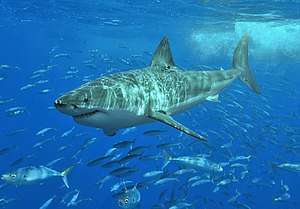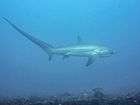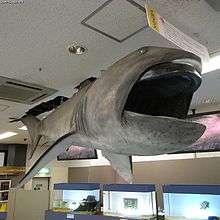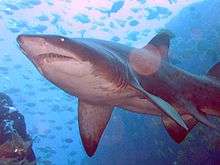Lamniformes
The Lamniformes (from the Greek word, Lamna "fish of prey") are an order of sharks commonly known as mackerel sharks (which may also refer specifically to the family Lamnidae). It includes some of the most familiar species of sharks, such as the great white,[2] as well as more unusual representatives, such as the goblin shark and megamouth shark.
| Lamniformes | |
|---|---|
 | |
| Great white shark, Carcharodon carcharias | |
| Scientific classification | |
| Kingdom: | Animalia |
| Phylum: | Chordata |
| Class: | Chondrichthyes |
| Subclass: | Elasmobranchii |
| Infraclass: | Euselachii |
| Superorder: | Selachimorpha |
| Order: | Lamniformes L. S. Berg, 1958 |
| Families | |
|
See Text | |
Members of the order are distinguished by possessing two dorsal fins, an anal fin, five gill slits, eyes without nictitating membranes, and a mouth extending behind the eyes. Species in two families of Lamniformes – Lamnidae and Alopiidae – are distinguished for maintaining a higher body temperature than the surrounding water.[3]
Species
The order Lamniformes includes 10 families with 22 species, with a total of seven living families and 17 living species:
Order Lamniformes
- Family Alopiidae Bonaparte, 1838 (thresher sharks)
- Genus Alopias Rafinesque, 1810
- Alopias pelagicus Nakamura, 1935 (pelagic thresher)
- Alopias superciliosus R. T. Lowe, 1841 (bigeye thresher)
- Alopias vulpinus (Bonnaterre, 1788) (common thresher)
- Alopias sp. not yet described
- Genus Alopias Rafinesque, 1810
- Family Anacoracidae Capetta, 1987 (crow sharks) †
- Genus Squalicorax
- Genus Telodontaspis
- Genus Pseudocorax
- Genus Galeocorax
- Genus Scindocorax
- Genus Nanocorax
- Genus Ptychocorax
- Family Cetorhinidae Gill, 1862
- Genus Cetorhinus Blainville, 1816
- Cetorhinus maximus (Gunnerus, 1765) (basking shark)
- Genus Cetorhinus Blainville, 1816
- Family Eoptolamnidae*†[4]
- Genus Eoptolamna†[4]
- Eoptolamna eccentrolopha
- Genus Leptostyrax*†[5][6]
- Genus Protolamna†[4]
- Protolamna sokolovi
- Protolamna borodini
- Protolamna carteri
- Protolamna compressidens
- Protolamna gigantea
- Protolamna roanokeensis
- Genus Eoptolamna†[4]
- Family Lamnidae J. P. Müller and Henle, 1838
- Genus Carcharodon A. Smith, 1838
- Carcharodon carcharias (Linnaeus, 1758) (great white shark)
- Carcharodon hubbelli †
- Genus Isurus Rafinesque, 1810
- Isurus oxyrinchus Rafinesque, 1810 (shortfin mako)
- Isurus paucus Guitart-Manday, 1966 (longfin mako)
- Genus Lamna Cuvier, 1816
- Lamna ditropis Hubbs & Follett, 1947 (salmon shark)
- Lamna nasus (Bonnaterre, 1788) (porbeagle)
- Genus Carcharodon A. Smith, 1838
- Family Megachasmidae Taylor, Compagno & Struhsaker, 1983
- Genus Megachasma Taylor, Compagno & Struhsaker, 1983
- Megachasma pelagios Taylor, Compagno & Struhsaker, 1983 (megamouth shark)
- Genus Megachasma Taylor, Compagno & Struhsaker, 1983
- Family Mitsukurinidae D. S. Jordan, 1898
- Genus Mitsukurina D. S. Jordan, 1898
- Mitsukurina owstoni D. S. Jordan, 1898 (goblin shark)
- Genus Mitsukurina D. S. Jordan, 1898
- Family Odontaspididae Müller & Henle, 1839
- Genus Carcharias Rafinesque, 1810
- Carcharias taurus Rafinesque, 1810 (sand tiger shark)
- Genus Odontaspis Agassiz, 1838
- Odontaspis ferox (Risso, 1810) (smalltooth sand tiger)
- Odontaspis noronhai (Maul, 1955) (bigeye sand tiger)
- Genus Carcharias Rafinesque, 1810
- Family Pseudocarchariidae Compagno, 1973
- Genus Pseudocarcharias Cadenat, 1963
- Pseudocarcharias kamoharai (Matsubara, 1936) (crocodile shark)
- Genus Pseudocarcharias Cadenat, 1963
- Family Cardabiodontidae †
- Genus Cardabiodon Siverson, 1999
- Cardabiodon ricki Siverson, 1999 †
- Cardabiodon venator Siverson and Lindgren, 2005 †
- Genus Cardabiodon Siverson, 1999
- Family Cretoxyrhinidae †
- Genus Cretoxyrhina Agassiz, 1843
- Cretoxyrhina vraconensis Zhelezko, 2000 †
- Cretoxyrhina denticulata Glückman, 1957 †
- Cretoxyrhina agassizensis Underwood and Cumbaa, 2010 †
- Cretoxyrhina mantelli Agassiz, 1843 (ginsu shark) †
- Family Otodontidae †
- Genus Carcharocles
- Carcharocles auriculatus (Jordan, 1923)
- Carcharocles angustidens (Agassiz, 1843)
- Carcharocles chubutensis (Agassiz, 1843)
- Carcharocles megalodon (Agassiz, 1843) (megalodon) † (genus disputed)
- Genus Cretalamna †
- Genus Carcharocles
| Family | Image | Common name | Genera | Species | Description |
|---|---|---|---|---|---|
| Alopiidae |  |
Thresher sharks | 1 | 3[7] | Thresher sharks are large sharks found in temperate and tropical oceans around the world. The common name refers to its distinctive, thresher-like tail or caudal fin which can be as long as the body of the shark itself. |
| Cetorhinidae | Basking sharks | 1 | 1 | The basking shark is the second largest living fish, after the whale shark, and the second of three plankton-eating sharks, the other two being the whale shark and megamouth shark. It is a cosmopolitan migratory species, found in all the world's temperate oceans. It is generally a harmless filter feeder with a greatly enlarged mouth, which cruises leisurely over huge distances covering three miles every hour. During each of those hours, it strains about 1.5 million l of water through more than 5,000 gill rakers for plankton.[8] Basking sharks have long been a commercially important fish, as a source of food, shark fin, animal feed, and shark liver oil. Overexploitation has reduced its populations to the point where some have disappeared and others need protection. | |
| Lamnidae |  |
Mackerel sharks | 3 | 5 | Mackerel sharks, also called white sharks, are large, fast-swimming sharks, found in oceans worldwide. They include the great white, the mako, and porbeagle shark. Mackerel sharks have pointed snouts, spindle-shaped bodies, and gigantic gill openings. The first dorsal fin is large, high, stiff and angular or somewhat rounded. The second dorsal and anal fins are minute. The caudal peduncle has a few or less distinct keels. The teeth are gigantic. The fifth gill opening is in front of the pectoral fin and spiracles are sometimes absent. They are heavily built sharks, sometimes weighing nearly twice as much as sharks of comparable length from other families. Many in the family are among the fastest-swimming fish. |
| Megachasmidae |  |
Megamouth sharks | 1 | 1 | The megamouth shark is an extremely rare species of deepwater shark, and the smallest of the three filter-feeding sharks. Since its discovery in 1976, only a few megamouth sharks have been seen, with 55 specimens known to have been caught or sighted as of 2012, including three recordings on film. Like the basking shark and whale shark, it is a filter feeder, and swims with its enormous mouth wide open, filtering water for plankton and jellyfish. It is distinctive for its large head with rubbery lips. It is so unlike any other type of shark that it is classified in its own family, though it may belong in the family Cetorhinidae of which the basking shark is currently the sole member. |
| Mitsukurinidae |  |
Goblin sharks | 1 | 1 | Goblin sharks have a distinctive long, trowel-shaped, beak-like snout, much longer than those of other sharks. The snout contains sensory organs to detect the electrical signals given off by the shark's prey.[9] They also possess long, protrusible jaws.[10] When the jaws are retracted, the shark resembles a grey nurse shark with an unusually long nose. Goblin sharks include one living genus and three extinct genera.[11] The only known living species is Mitsukurina owstoni. |
| Odontaspididae |  |
Sand sharks | 2 | 3 | Sand sharks are so-called because they inhabit sandy shorelines, and are often seen trolling the ocean floor in the surf zone. They are found in warm or temperate waters throughout the world's oceans, except the eastern Pacific.[12] Sand sharks have a large second dorsal fin. They grow up to 10 feet in adult length.[13] The body tends to be brown in color with dark markings in the upper half. These markings disappear as they mature. Their needle-like teeth are highly adapted for impaling fish, their main prey. Their teeth are long, narrow, and very sharp with smooth edges, with one and on occasion two smaller cusplets on either side.[14] |
| Pseudocarchariidae |  |
Crocodile sharks | 1 | 1 | Only one species is in the crocodile shark family. It is a specialized inhabitant of the mesopelagic zone, found worldwide in tropical waters from the surface to a depth of 590 m (1,940 ft). It performs a diel vertical migration, staying below a depth of 200 m (660 ft) during the day and ascending into shallower water at night to feed. Typically measuring only 1 m (3.3 ft) in length, the crocodile shark is the smallest living mackerel shark. It can be distinguished by its elongated, cigar-shaped body, extremely large eyes, and relatively small fins. Substantial numbers are caught as bycatch, leading it to be assessed as Near Threatened by the International Union for Conservation of Nature. |
| †Anacoracidae |  |
†Anacoracidae | 5 | Contains 5 genera of shark from the Cretaceous, most notably Squalicorax, found worldwide. | |
| †Cardabiodontidae | †Cardabiodontidae | 2 | 5 | Extinct, the Cardabiodontidae include Cardabiodon and Dwardius, both genera from the Cretaceous which have existed in Australia, Canada, and Europe.[15] | |
| †Cretoxyrhinidae |  |
†Cretoxyrhinidae | 1 | 4 | Extinct, the Cretoxyrhinidae includes the sole member Cretoxyrhina (pictured), a genus from the Cretaceous.[16] |
| †Otodontidae |  |
†Otodontidae | 3 | 27 | Extinct, the Otodontidae lived from the early-mid Cretaceous to the Pliocene, and reached huge sizes. A disputed possibility exists that the Carcharocles sharks derived from Otodus, which would mean that Cretalamna would belong in this group. Also, a disputed possibility exists that megalodon (pictured), the largest shark ever, belongs to the group.[17] |
Sustainable consumption
In 2010, Greenpeace International added the shortfin mako shark (Isurus oxyrinchus) to its seafood red list. [18]
References
- Froese, Rainer, and Daniel Pauly, eds. (2009). "Lamniformes" in FishBase. January 2009 version.
- Pimiento, Catalina; Cantalapiedra, Juan L.; Shimada, Kenshu; Field, Daniel J.; Smaers, Jeroen B. (24 January 2019). "Evolutionary pathways toward gigantism in sharks and rays". Evolution. 73 (2): 588–599. doi:10.1111/evo.13680. PMID 30675721.
- Donley, Jeanine M.; Sepulveda, Chugey A.; Aalbers, Scott A.; McGillivray, David G.; Syme, Douglas A.; Bernal, Diego (2012-04-13). "Effects of temperature on power output and contraction kinetics in the locomotor muscle of the regionally endothermic common thresher shark (Alopias vulpinus)". Fish Physiology and Biochemistry. 38 (5): 1507–1519. doi:10.1007/s10695-012-9641-1. ISSN 0920-1742.
- Kriwet, Jürgen; Klug, Stefanie; Canudo, José I.; Cuenca-Bescos, Gloria (October 2008). "A new Early Cretaceous lamniform shark (Chondrichthyes, Neoselachii)". Zoological Journal of the Linnean Society. 154 (2): 278–290. doi:10.1111/j.1096-3642.2008.00410.x.
- Frederickson, Joseph A.; Schaefer, Scott N.; Doucette-Frederickson, Janessa A. (3 June 2015). "A Gigantic Shark from the Lower Cretaceous Duck Creek Formation of Texas" (PDF). PLOS ONE. 10 (6): e0127162. doi:10.1371/journal.pone.0127162. PMC 4454486. PMID 26039066.
- "20-Foot Monster Shark Once Trolled Mesozoic Seas". livescience.com. Retrieved 7 April 2018.
- Froese, Rainer, and Daniel Pauly, eds. (2013). "Alopiidae" in FishBase. October 2013 version.
- Basking shark BBC Nature, 13 March 2013. Retrieved 28 March 2013.
- Stevens, J.; Last, P.R. (1998). Paxton, J.R.; Eschmeyer, W.N. (eds.). Encyclopedia of Fishes. San Diego: Academic Press. p. 63. ISBN 0-12-547665-5.
- Froese, Rainer and Pauly, Daniel, eds. (2005). "Mitsukurina owstoni" in FishBase. 10 2005 version.
- "Mitsukurinidae". www.helsinki.fi. Retrieved 7 April 2018.
- National Geographic. "Sand Tiger Sharks". National Geographic. Retrieved 8 December 2012.
- Froese, Rainer, and Daniel Pauly, eds. (2009). "Odontaspididae" in FishBase. January 2009 version.
- Bigelow, Henry B.; Schroeder, William C. (1953). Fishes of the Gulf of Maine. United States Government Printing Office. Retrieved 30 October 2011.
- Mikael Siverson; Marcin Machalski (2017). "Late late Albian (Early Cretaceous) shark teeth from Annopol, Poland". Alcheringa: An Australasian Journal of Palaeontology. 41 (4): 433–463. doi:10.1080/03115518.2017.1282981.
- Mikael Siverson (1999). "A new large lamniform shark from the uppermost Gearle Siltstone (Cenomanian, Late Cretaceous) of Western Australia". Transactions of the Royal Society of Edinburgh: Earth Sciences. 90 (1): 49–66. doi:10.1017/S0263593300002509.
- Joseph S. Nelson (2006). "Order Lamniformes". Fishes of the World (4th ed.). John Wiley and Sons. pp. 57–60. ISBN 978-0-471-25031-9.
- Greenpeace International Seafood Red list Archived 2010-04-10 at the Wayback Machine
Further reading
- Compagno, Leonard (2002) Sharks of the World: Bullhead, mackerel and carpet sharks Volume 2, FAO Species Catalogue, Rome. ISBN 92-5-104543-7.
- Joseph S. Nelson (2006). "Order Lamniformes". Fishes of the World (4th ed.). John Wiley and Sons. pp. 57–60. ISBN 978-0-471-25031-9.